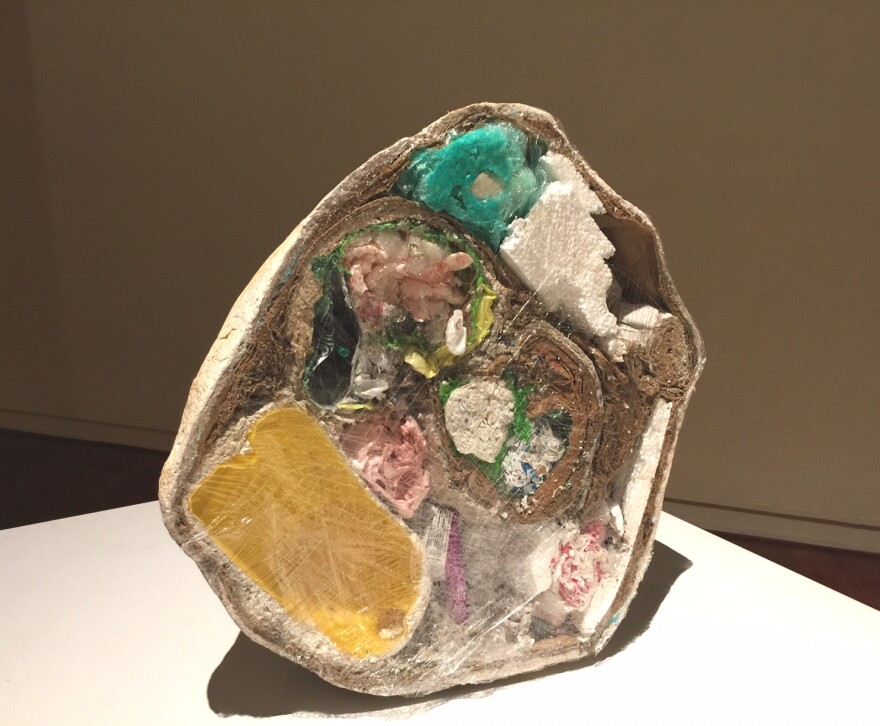This is the last weekend to enjoy a particularly splash making exhibit at Spalding House in Makiki. “Plastic Fantastic?” features beautiful art made of or about plastic debris. In addition, HPR’s Noe Tanigawa reports there’s progress on ways to deal with this ubiquitous, non-disposable substance.
“Plastic Fantastic?”continues at the Honolulu Museum of Art’s Spalding House in Makiki through Sunday.

Octrober 2, 2016.
Spalding House Director Aaron Padilla didn’t know what he was getting into at first.
“This project’s ruined my life! I was just really frustrated!”
He ranted to Kim Johnson of K?kua Hawai‘i Foundation, who proposed the original idea: A show about plastic debris to coincide with the World Conservation Congress.
“And she started laughing and I was laughing too, but seriously, prior to this, I didn’t know. It was like okay, yeah plastic, I get it, whatever. Doing this exhibition, for me, it was like, wow, this isn’t okay.”
“Plastic as a material made our lives that much easier. It was easier, quicker, cheaper to make things. No longer do you have to chop down a tree or process metal, you can just have this chemical concoction with this petroleum resource, you can make this miracle material that is really durable and cheap that lasts forever.”
“That’s the irony of it, right?" says Padilla. "Mankind creates this material that is everlasting, cheap and accessible but it becomes disposable. So the thing that we have that is everlasting is the thing we use once and throw away. That is the design flaw.”
Understanding that, really does take the joy out of plastic water bottles. Is there any good news?

“Yes! There is good news.” Says Natalie McKinney, Executive Director of the K?kua Hawai‘i Foundation. One big step forward was the plastic bag ban, of course the heavier "reusable" ones are still around, but McKinney says, we'll get over that.
“We’re really seeing children, youth, becoming these activists, these change makers within our communities. They’re coming up with creative solutions and are really looking to push the needle.”
McKinney points to Le Jardin Academy’s new plastic free lunch program and Maui students and their #SporkItUp campaign against disposable flatware.
“We are with the "bring your own", so bring your own utensils. Straws are the big thing now. And we’re also seeing a lot of momentum around establishments and businesses and their reduction of single use plastics. It’s these little things we can do in our personal lives and our daily lives that can make a difference. And for those of you who are really super vigilant and want to get engaged, legislation is where it’s at. Styrofoam is the next biggie on the list.”

McKinney says several groups will be pressing for a styrofoam ban at the legislature next year. She's excited about the students who testified before the Hawai'i County Council this past year in support of a styrofoam ban because their desire for a more sustainable planet is driving them toward civic engagement. Spontaneous beach cleanups have been springing up, publicized @808Cleanups, and you can now look for the Ocean Friendly decal at over a hundred restaurants signifying their swing to reusables and compostables.
“If the world is producing 50 billion tons of this per year, I’m sitting on an endless supply of material that I can turn into something else that’s useful. Whoever cracks that, they got it made!” says Padilla.
Meanwhile, some artists are using plastic to produce thoughtful, even beautiful art works, check Aurora Robson’s work, above, and in"Plastic Fantastic?"at Spalding House through October 2, 2016.





